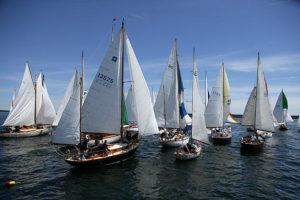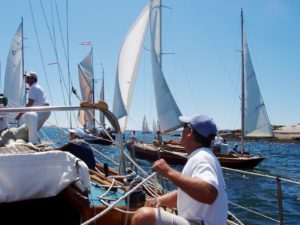Let’s begin with the disclosures: We didn’t just spend two weeks racing Vintage, Classic and Spirit-of-Tradition yachts. We spent a lot of time during those races thinking about racing: How to organize these modern-classic events more effectively; how to class boats more fairly; how to handicap the yachts more properly and how to make these events more inclusive, rather than more exclusive.
This brainwork was part of a reasonably rigorous market survey we are conducting of the Vintage, Classic and Spirit-of-Tradition racing fleets. The full report is due out later this year. But even now, we are finding solid lessons from this year’s Camden Classic Cup, and the racing series leading to the Eggemoggin Reach Regatta.
Lessons that any racer or race organizer can learn from from.

Good classing and balanced courses helps avoid mark-rounding pile ups.
1) More Classes are Better than Less.
Without question, when race organizers follow logical guidelines and fine tune how boats were classed, racing improves. Whether it be splitting a group of daysailers by design, or, keeping an America’s Cup racer in a class given its design date, it’s important to remain innovative in grouping yachts. Good organization, and clear guidelines for classing boats make for fair starts and reasonably organized traffic congestion. The addition of the beautifully picturesque landscape we view while racing makes these classic Maine regattas so classic.
To us, fleet organization is top priority. And clear, logical, guidelines for splitting a fleet actually encourages more participation, rather than less, and is truly the future of mixed-fleet, modern and vintage racing.
2) Unbalanced Courses Need To Be Carefully Reviewed.
Unbalanced courses, that have unequally long beats, runs and reaches, can provide racers with great sightseeing. The views from the long reaches through Penobscot Bay found in the Castine-Camden and Camden-Brooklin races make those events special. But the courses that seek to balance the different phases of sailing, will offer a better experience at the finish line.
The balanced course keeps handicapping adjustments more accurate and helps streamline even results.
While we realize that Olympic-regatta precision of equal parts reach, run and beat, are not possible in many regatta events, we see no reason why races can’t be more focused on some sort of relative equal length of reaches, runs and beats. Not all victories in a regatta are about crossing the finish line first, or winning on corrected time. It’s the “being there,” and the trying hard, in good style, that makes for a win for all those who participate.
And it is the balanced race course that is the most fun to sail.

The events that make communication king, seem to offer the best experience.
3) Communication Is King.
Over and over, we saw success in this summer’s racing due to the power of getting the word out. Race organizers that distributed class rules, organized on-shore events and made it clear why races were organized they way they were, held better races.
Skippers seemed to understand and appreciate how their rating works and why their boat is up against a given competitor. Even in moments of controversy, when small faults may be exposed, the overall on-water experience was enjoyable, competitive and about learning what is working well, sensibly over time.
Could the secret to a successful Classic and Spirit-of-Tradition race merely be about taking the time to talk it all through?
We think so.